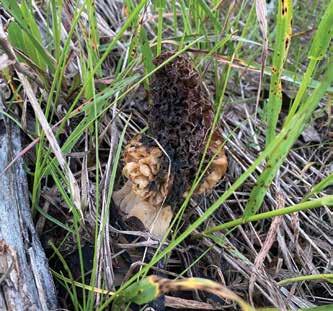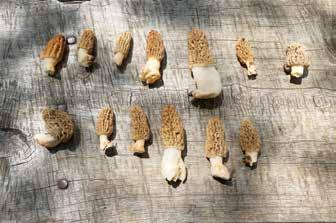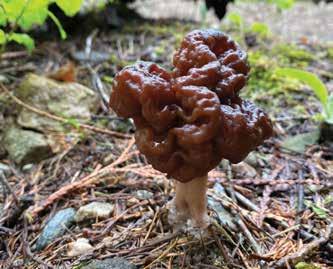
3 minute read
Field Guide
COOKING WITH MOREL MUSHROOMS & FIDDLEHEADS

Written by Rob LeClair
If you’ve ever enjoyed morels or fiddleheads—as a side dish glistening in butter, in a sauce over risotto or in a rich bisque—you’ll know why these exquisite wild foods are so sought after by chefs and foodies. The decadent, nutty taste of morel mushrooms is a fleeting bliss I look forward to every spring. This is another reason why morels and fiddleheads are so special: they are only grown in the wild, they are elusive and they can only be foraged over several weeks and must be cooked within days.



We’re very fortunate at Nature’s Fare Markets to have these two ingredients in stores as soon as they’re harvested. Now that you’ve had the chance to learn about wild mushroom foraging from West Coast Wild Foods—and knowing that you might only have a few chances to get it right each spring—I wanted to share my personal tips to find, shop, prep and cook two of my favourite seasonal delights: morel mushrooms and fiddleheads.
In foraging for fiddleheads, I’ve always had the best luck searching close to brooks and streams. They thrive in damp ground and shady areas (in fact, fiddleheads are actually young ostrich ferns). Once you find a patch, harvest carefully and lightly. Don’t over-harvest if you want to return to this spot the following spring. Look for tightly curled heads that are bright green. Take only the young tops that have not begun to unfurl, snapping off very close to the ground.
When buying fiddleheads, choose small, firm fiddleheads that have a bright jade colour; avoid those with yellow or soft patches. Use

Morel Mushroom Risotto

Serves 2
6 cups stock (vegetable, veal, chicken or mushroom)
2 cups dry hard cider (or dry white wine)
1 small onion, minced 2–3 cloves garlic, minced 2 tbsp olive oil
1 tsp thyme (fresh or dried)
1 cup Arborio rice (or Carnaroli if you can get it)
¼ lb morel mushrooms
½ cup Parmesan or pecorino cheese, finely grated
2 tbsp butter fiddleheads as soon as possible. They can be refrigerated for up to two days, tightly wrapped in plastic. Before cooking, wash them thoroughly, scrape off any fuzzy brown scales and trim the ends. Fiddleheads should not be eaten raw; they must be cooked.
1. Bring stock to a simmer in a medium saucepan.
2. In another medium saucepan, sauté the onion and garlic in olive oil until translucent, about 5 minutes.
3. Add about half the morels along with thyme and sauté for another minute.
4. Add rice to the onion mixture and cook while constantly stirring for about 1–2 minutes until the rice becomes slightly opaque. Season with salt and adjust the heat to keep garlic from browning.
5. Add cider or wine and stir. Allow to the liquid to be absorbed almost completely.
6. Add the hot stock one ladle at a time, stirring frequently, until the stock has been absorbed before adding more, until the rice is slightly al dente. This should take 20–30 minutes of simmering and stirring (or forego a timer and drink a glass of wine instead). The stirring helps to release the starch from the rice and creates a creamy texture. Taste and adjust seasoning if needed.
7. When the rice has absorbed all the liquid and is creamy, remove it from the heat. Add the cheese and stir until it is completely melted.
8. Sauté the remaining morels in butter for 5 minutes. Divide the risotto between plates and top each plate with the sautéed morels. Add more cheese if desired.
With fiddleheads, I always cook simply. I tend to serve them the way I would asparagus—topped with a vinaigrette; a butter, cream or cheese sauce; or even a soy sauce sprinkled with sesame seeds.
Growing up in Ontario, we hunted morels in old apple orchards, near streams and in the beds of pine and oak trees. Morels come up in late spring, and I’ve known people who check the soil temperature to know when to head out hunting for these rare, honeycomb-shaped fungi.
Morels, as with other wild fungi, can easily be misidentified and cause serious illness, so if you’re just getting started, it’s safest to go foraging with an experienced guide.
If you’re happy to let others do the harvesting and get right to tasting, when buying morels, look for ones that are plump with a moist stem. The darker in colour, the more nutty and earthy the flavour. Take home only those that are moist, and avoid morels that are totally dry, brittle, bruised or softening. Once you get your fresh morels home, soak them in saltwater for 10 minutes so they’re free of any occupants (i.e., insects). Try out my all-time favourite recipe on the previous page: Morel Mushroom Risotto.
“I love to use fiddleheads in brunch dishes; for example blanched and put into a quiche with sundried tomatoes or a frittata with mushrooms (morels!), bacon and chèvre. Another crowd pleaser I’ve done in the past is a take on pissaladière from Provence—a puff pastry tart with caramelized onion, but instead I use buttered leeks, blanched fiddleheads and gruyere. All great for a special brunch.









